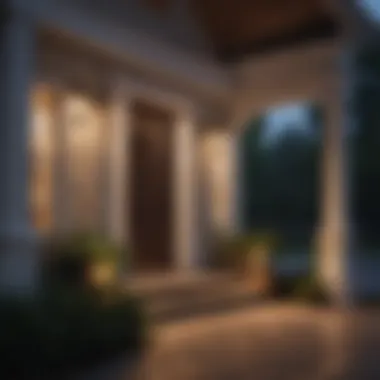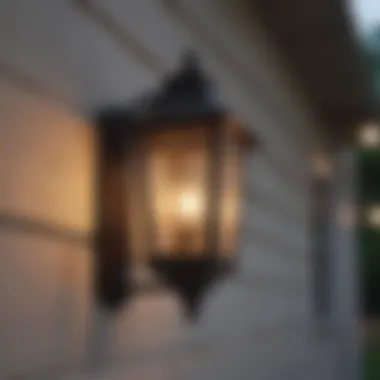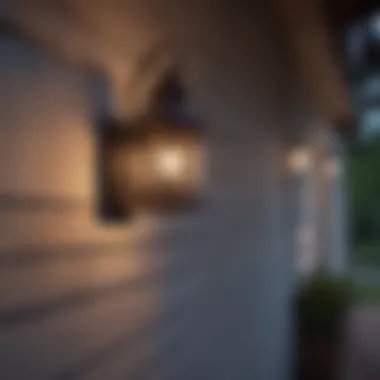Exterior Front Porch Lighting: A Comprehensive Guide


Intro
In the realm of home improvement, exterior front porch lighting holds a pivotal role. It not only enhances the aesthetic appeal of a residence but also significantly contributes to safety and functionality. Homeowners and renters alike can benefit from understanding the various aspects of porch lighting, including styles, designs, and installation techniques.
This guide presents a thorough exploration of these elements, emphasizing the importance of thoughtful selection and placement of lighting fixtures. From mid-century modern looks to classic colonial designs, the choices available can harmonize with a home’s architectural style while providing practicality.
Another crucial factor is energy efficiency, a consideration that aligns with modern sustainability goals. The use of LED bulbs, for example, provides a longer lifespan and reduced energy consumption compared to traditional lighting options.
Equipped with knowledge about the latest trends and practical tips for installation and maintenance, readers can make informed decisions that amplify both the beauty and safety of their front porches.
Key Insights and Trends
The world of exterior front porch lighting is ever-evolving, shaped by current design trends and technologies. It is valuable to understand where this field is heading to make adjustments to one’s own space.
Current Trends in Lighting Design
- Minimalist Designs: Simple, clean lines are favored
- Smart Lighting Technology: Integrated systems that allow for remote control and automation are rising in popularity
- Sustainable Options: Solar-powered lights and energy-efficient bulbs are essential in modern designs
These trends reflect a shift towards functionality while ensuring homes remain stylish.
Energy Efficiency Considerations
Choosing energy-efficient lighting options not only lowers electric bills but also reduces a household's carbon footprint. LED lights stand out for their low energy consumption and longevity.
Energy-efficient options offer homeowners an opportunity to enhance their spaces sustainably.
Practical Tips and How-To Guides
When approaching the installation and maintenance of exterior front porch lighting, several practical steps can ensure a successful outcome.
Step-by-Step Installation Guide
- Choose the Right Fixtures: Select fixtures that complement your home’s style. For example, lantern-style fixtures suit rustic homes.
- Plan Placement: Position lights to avoid glare and ensure the entire porch is well-lit.
- Consider Height: Fixtures should be mounted at an appropriate height for optimal illumination.
Maintenance Tips
- Regularly clean fixtures to prevent dust buildup and maintain brightness.
- Replace burnt-out bulbs promptly to ensure safety.
By following these guidelines, homeowners can create a safe and inviting atmosphere on their front porches.
Understanding Exterior Front Porch Lighting
Exterior front porch lighting serves multiple crucial functions that go beyond mere illumination. It is essential for creating a welcoming atmosphere, which is particularly valuable for homeowners aiming to enhance curb appeal. However, this topic is intertwined with various other aspects that merit deeper exploration.
Defining Purpose
The primary role of porch lighting is to provide adequate illumination for safety and convenience. This includes ensuring that pathways and entryways are well-lit, preventing accidents during night-time arrivals or departures. A clearly defined purpose allows homeowners to determine the placement and type of lighting fixtures to employ. Moreover, different occasions may dictate varying purposes; for instance, hosting gatherings might require a more relaxed lighting scheme, while regular evening activities necessitate functional brightness.
Aesthetic Enhancement
Beyond functionality, exterior lighting contributes significantly to the aesthetic value of the property. Thoughtfully chosen lighting can accentuate architectural features, highlight landscaping, and create an inviting environment for guests and residents alike. Choices in fixtures, wattage, and bulb placement should harmonize with the existing design. For example, vintage lanterns may complement a traditional design, while sleek, minimalist fixtures suit modern homes. Achieving a cohesive look with lighting enhances overall home beauty, making it enjoyable for residents and appealing to visitors.
Safety and Security Considerations


A well-lit porch is not only aesthetically pleasing but also vital for safety and security. A dimly lit exterior can attract unwanted attention and might increase the risk of accidents. Adequate lighting serves as a deterrent to potential intruders while providing peace of mind to homeowners. It’s essential to consider the placement of lights in dark corners, as well as the choice of bulbs that provide bright illumination without being harsh. Motion-detecting lights are also practical for increasing security, as they activate when movement is detected, ensuring the porch remains lit without energy wastage when not needed.
Effective exterior lighting ensures not just beauty but also safety, making it a dual-purpose element worth careful planning.
Types of Porch Lighting
The selection of porch lighting is more than just a decorative choice; it plays a crucial role in establishing a well-lit and inviting exterior for homes. Porch lighting can serve various functions, from enhancing the beauty of the space to providing safety and comfort. Understanding the different types of porch lighting can help homeowners make informed decisions that suit their needs and preferences.
Ambient Lighting
Ambient lighting is the foundation of any lighting plan. It creates an overall glow in the porch area and establishes a welcoming atmosphere. This type of lighting is crucial for visibility and encourages comfort for those using the space.
Key considerations for ambient lighting include:
- Location: Positioning lights to engage the entire area, while avoiding harsh shadows.
- Fixture Type: Choosing fixtures such as wall sconces or ceiling-mounted lights that diffuse soft light.
- Brightness Control: Dimmers can be integrated to adjust brightness, allowing homeowners to set the mood or provide more light as needed.
In essence, ambient lighting sets the tone and ensures safety, making it an indispensable aspect of porch lighting design.
Task Lighting
Task lighting is specifically designed to illuminate areas where specific activities occur. This is particularly useful in spaces where people may be performing tasks such as reading or socializing. Task lighting should be adequate enough to facilitate activities without causing glare.
Important factors for task lighting include:
- Light Placement: Lights should be placed directly above or near the task area for optimum visibility.
- Fixture Style: Using pendant lights, wall-mounted fixtures, or even adjustable fixtures can enhance functionality.
- Usage: Consider the primary activities that will occur in the porch area when choosing the type of task lighting needed.
By focusing on functionality, task lighting enhances usability while maintaining an inviting atmosphere.
Accent Lighting
Accent lighting adds layer and depth to the porch. It highlights architectural features, plants, and decorations, thereby enhancing the visual appeal of the space. This type of lighting plays a complementary role to ambient and task lighting, creating a more dynamic lighting scheme.
For successful accent lighting, pay attention to:
- Highlighting Features: Identifying elements that could benefit from additional focus, such as columns or artwork.
- Light Sources: Utilizing spotlights or directional fixtures to draw attention.
- Balance: Ensuring that accent lighting does not overwhelm the space but instead complements existing lighting.
Accent lighting imparts character and enhances the overall aesthetic, making it an important element in the porch lighting plan.
Choosing the right types of porch lighting is essential for blending functionality with aesthetics, ensuring safety and inviting warmth for all who approach.
Designing an Effective Lighting Plan
Designing an effective lighting plan is essential for enhancing the functionality and appeal of exterior front porches. A well-thought-out plan takes into consideration how the space will be used, the aesthetic desired, as well as safety and practicality. Getting this right can transform a porch from a mere entryway into a welcoming space, while also addressing visibility and security concerns.
Assessing Spatial Layout
Assessing the spatial layout is the first step in developing a lighting plan. Consider the dimensions of the porch and how it relates to adjacent spaces like walkways and gardens. This helps in determining the placement of lights. Proper spacing is crucial. Too few fixtures may leave dark areas, while too many can create an overly bright environment.
When looking at layout, think about how people will use the porch. If the area is for sitting and socializing, brighter lights can help set an inviting atmosphere. For purely functional installations, consider more direct lighting focused on entrances and pathways. A diagram or sketch can be helpful here.
Selecting Fixture Styles
Selecting the right fixture styles involves consideration of architectural compatibility and personal taste. Various styles can complement your home's aesthetic while providing necessary functionality.
Traditional


Traditional fixtures often embody classic designs that include ornate details. These are beneficial for homes with historical or vintage elements. The key characteristic of traditional lighting is its timeless appeal. It tends to blend well in various settings, making it a popular choice. Unique features include intricate patterns and materials like brass or wrought iron. However, the disadvantage can be the upkeep, as some materials may require regular polishing to maintain their luster.
Modern
Modern fixtures are characterized by sleek lines and minimalistic designs. They often appeal to those seeking a contemporary look and tend to be very functional. The key aspect of modern lighting is its focus on simplicity and efficiency. Unique features often include integrated LED technology for energy savings. One downside can be the limited variety for those who prefer a more ornate aesthetic.
Rustic
Rustic fixtures bring a touch of nature and organic materials into the design scheme. They often feature wood, metal, or glass elements that invoke a cozy, warm feeling. The key characteristic is their rough, unrefined look that adds a charming touch. This style is appealing for homes in rural areas or those with a cabin-like ambiance. However, they might not suit more polished or urban designs, which is a crucial disadvantage.
Minimalist
Minimalist lights emphasize simplicity and functionality above all else. They are an excellent choice for those who prefer a streamlined, clean look. The key feature is the lack of excessive decoration, focusing instead on essential functionality. Minimalist fixtures can often be cost-effective and quite versatile. One disadvantage of this style is that it may come across as stark or impersonal in some contexts.
Color Temperature and Bulb Selection
Once the fixture style is selected, the next step is understanding color temperature and bulb selection. Color temperature affects the mood and visual comfort of the porch space. Ranging from soft warm tones to bright daylight hues, the choice can drastically alter the ambiance.
Opt for bulbs that promote feeling safe and comfortable, particularly for entryways. Soft white bulbs are often favorable for social areas, whereas brighter LEDs may be more suitable for functional lighting tasks. Adjustable dimmer systems can provide flexibility, allowing users to change the mood as needed.
Practical Considerations for Installation
When installing exterior front porch lighting, several practical considerations are crucial to ensure both functionality and safety. A well-planned installation not only enhances the visual appeal of your home but also improves its security. Understanding how to approach installation can save time, money, and reduce risks associated with electrical work and weather exposure.
Location and Mounting Heights
Selecting the right location for your porch lights is key. Functionality should guide your decision. Placing lights at entry points, such as the front door, is essential for visibility and safety. However, consider how the light interacts with existing architectural features. You want to enhance, not overshadow, them.
Mounting heights are equally important. Lights should be installed at a height that maximizes their illumination while preventing glare. A common guideline is to mount wall sconces at about 60 to 66 inches from the ground. This height allows the light to shine where needed, while providing a welcoming glow without being harsh.
Wiring and Electrical Requirements
Proper wiring is vital for the successful operation of porch lighting. Ensure compliance with local electrical codes. Using the correct fixtures and wiring types can avoid electrical hazards and inefficiencies.
First, using outdoor-rated wiring is mandatory to withstand moisture exposure. Also, consider the load on your circuits. Overloading can lead to tripped circuits or overheating. Additionally, it's advisable to install a dedicated circuit for your porch lights, especially if using high-wattage bulbs.
In many cases, hiring a licensed electrician for installation can prevent costly mistakes. They have the expertise to layout wiring effectively, providing peace of mind.
Weather Resistance and Durability
The exterior environment can be harsh. Consequently, selecting fixtures that withstand weather conditions is necessary. Look for lights that are IP-rated, indicating their resistance to water and dust. An IP rating of 65 or higher is generally suitable for porch lighting.
Durability also depends on the materials used. Metals such as stainless steel or aluminum are resistant to rust, while high-grade plastics can endure impacts and UV exposure. Investing in durable fixtures can minimize long-term maintenance and replacement costs.
Using weather-resistant and durable fixtures enhances the longevity of your exterior porch lighting and reduces maintenance tasks.
By considering location and mounting heights, adhering to electrical codes, and ensuring weather resistance, you can achieve practical installations that enhance your home’s exterior while ensuring safety.
Energy Efficiency and Smart Lighting Options
When considering exterior front porch lighting, energy efficiency and smart lighting options stand at the forefront of modern lighting design. These elements not only help in reducing energy consumption, but they also contribute to long-term cost savings. With the increasing concerns about environmental impact, choosing energy-efficient solutions has become essential for homeowners. Smart technology offers additional benefits by improving usability and customizing lighting to fit individual lifestyles.
LED versus Traditional Bulbs


LED bulbs have transformed lighting choices due to their superior energy efficiency compared to traditional incandescent bulbs. LED bulbs consume significantly less energy, lasting up to 25 times longer than their older counterparts. This longevity means that users will frequently save on replacement costs as well.
- Energy Consumption: LEDs typically use about 75% less energy.
- Longevity: An average LED can last 15,000 to 50,000 hours, while incandescent bulbs last about 1,000 hours.
- Heat Emission: LEDs emit very little heat, making them safer to use in outdoor settings.
While the upfront cost for LEDs may be higher, the reduced energy bills and longer lifespan lead to better value over time. Shifting to LED lighting can significantly decrease the environmental footprint of a home.
Solar-Powered Lighting Solutions
Solar-powered lighting solutions present a viable alternative for eco-conscious homeowners. These lights harness sunlight to produce energy, allowing homeowners to reduce reliance on electricity.
Advantages include:
- No Electricity Costs: By relying on solar, homeowners save on energy bills.
- Easy Installation: Most solar lights are wireless, leading to less complicated setup.
- Low Maintenance: Solar lights typically require minimal upkeep, mostly involving occasional cleaning of solar panels.
However, they do depend on sunlight, posing potential limitations in areas with less direct sunlight. Homeowners should strategically place solar lights where they can obtain adequate exposure to light, especially during winter months.
Incorporating Smart Technology
Smart technology in lighting has modernized how homeowners interact with their porch lighting. Smart systems enable remote control of lights, allowing adjustments via smartphone apps or voice-activated devices. This feature enhances convenience, particularly for owners who frequently entertain outdoors or may forget to turn off lights.
Some noteworthy benefits of integrating smart lighting include:
- Customization: Users can program lighting to suit events, adjusting brightness and color according to the occasion.
- Energy Monitoring: Smart systems often come with energy monitoring tools, enabling users to track energy usage and adjust accordingly.
- Security Features: Smart lights can be set on schedules or motion sensors, contributing to home security when owners are away.
Maintenance and Upkeep of Porch Lighting
Proper maintenance and upkeep of porch lighting is essential for enhancing both aesthetics and functionality. Over time, outdoor lighting fixtures can accumulate dirt, grime, and even biological growth like mold or mildew. Regular maintenance not only ensures that the fixtures remain visually appealing but also guarantees optimal performance. When lighting is neglected, it can lead to reduced brightness, malfunctioning bulbs, and even safety hazards. Keeping the fixtures in top condition will also extend their lifespan, making your investment worthwhile. It is advisable to incorporate maintenance routines into your seasonal household checklist.
Regular Maintenance Checklist
To ensure your porch lighting remains functional and attractive, consider adhering to a regular maintenance checklist. Following these steps can help identify potential issues before they become larger problems:
- Inspect Fixtures: Check for damage, corrosion, or wear on the fixtures.
- Clean Regularly: Remove dirt and debris from fixtures to maintain brightness.
- Check Bulbs: Regularly monitor bulb performance and brightness levels.
- Test functionality: Ensure the lights are turning on and off as intended.
- Review Wiring: Inspect wiring for any visible damage or wear.
Cleaning and Care for Fixtures
Cleaning plays a pivotal role in maintaining the effectiveness of your porch lighting. Begin by turning off the power to avoid any electrical hazards. Use a soft cloth or sponge and mild soap mixed with water to wipe down the fixtures. Harsh chemicals can damage finishes, so it's best to avoid them. For metal fixtures, a specialized cleaner can help remove rust or oxidation without causing harm.
- Glass Components: For lights with glass parts, use a glass cleaner that is appropriate for outdoor use to avoid streaks or residue.
- Avoid Abrasive Tools: Never use steel wool or other abrasive cleaning materials that could scratch or dull the surface.
Replacing Bulbs and Components
Bulbs and other components may require periodic replacement. When replacing bulbs, it’s important to follow the manufacturer's recommendations regarding wattage and type to avoid overheating issues. Always ensure that the power is off when changing bulbs to prevent electric shock.
- Choose the Right Bulb: Consider energy-efficient options like LED bulbs for long-term cost savings.
- Check Gaskets and Seals: When replacing, inspect the gaskets and seals. If these are worn or damaged, they may allow moisture to seep in, leading to further complications.
As you maintain your porch lighting, keep in mind that regular attention minimizes long-term costs and enhances overall safety. By following these guidelines, you can extend the life of your fixtures and ensure that your porch remains well-lit and inviting.
Culmination
Exterior front porch lighting serves multiple essential roles that extend beyond mere functionality. It is a critical part of the overall home design that enhances aesthetic appeal while promoting safety and security. Understanding this importance provides homeowners with practical insights into effective lighting choices. When meticulously planned, the right lighting can transform the porch into an inviting space while preventing accidents and deterring unwanted visitors.
Summary of Key Points
- Purpose of Lighting: The effective use of porch lighting combines aesthetic enhancement with practical safety considerations.
- Types of Lighting: Three significant types of porch lighting have been discussed: ambient, task, and accent, each fulfilling a distinct role.
- Effective Planning: A proper lighting plan involves assessing spatial layout, selecting appropriate fixture styles, and considering color temperature to create the desired atmosphere.
- Installation Considerations: Practical aspects, including mounting heights, wiring, and durability against weather elements, are relevant for long-lasting installations.
- Energy Efficiency: With modern technologies such as LED and solar lighting, homeowners can make choices that are sustainable and cost-efficient.
- Ongoing Maintenance: Regular checks and maintenance keep the lighting fixtures in optimal condition, maintaining both safety and style.
Final Recommendations
- Evaluate the Current Light Situation: Assess your existing porch lighting. Determine the need for additional or replacement fixtures.
- Choose the Right Style: Consider the architectural style of your home when selecting fixture styles to ensure a cohesive look.
- Plan for Energy Efficiency: Explore LED and solar options for their energy-saving benefits and environmental impact.
- Prioritize Safety: Ensure that all fixtures are adequately wired and securely mounted to create a safe environment for family and guests.
- Schedule Regular Maintenance: Implement a maintenance schedule that includes cleaning fixtures and checking bulbs to prolong the lifespan of the lighting.
By focusing on these elements, homeowners can enhance their front porch’s functionality and visual appeal. This comprehensive understanding of exterior porch lighting will lead to informed decision-making for anyone looking to improve their home’s exterior.



